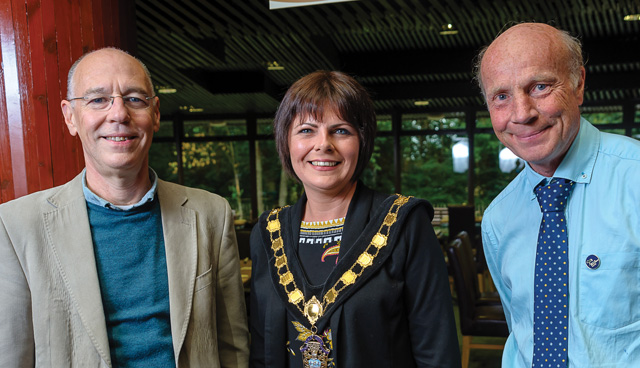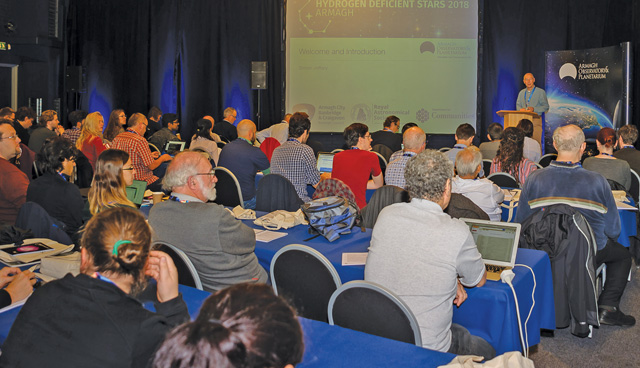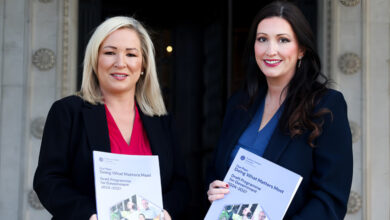Armagh proves a stellar success for international astronomy conference

The Armagh Observatory and Planetarium is an exemplar for Northern Ireland on the world stage, an institution excelling in research and public outreach in science, set within a heritage environment with a rich in scientific history.
September 2018 saw over 50 Astronomers from 16 nations gather at Armagh Observatory and Planetarium to discuss and debate their current research about Hydrogen-Deficient Stars.
Professor Simon Jeffery, Chair of the Organising Committee explains what Hydrogen-Deficient Stars are and how the conference came about: “Most of the lights we see in the night sky are stars…objects like the Sun which generate their own light and shine by themselves. Stars come in all sorts, from ten thousand times fainter to a million times brighter than our Sun. Some shine for tens of billions of years, and some burn themselves out in a few thousands. But all are made of the same stuff that was made in the Big Bang: nine atoms of hydrogen to one atom of helium, the two simplest atoms in the Universe.
Thus, it is very peculiar when we find a star that contains NO hydrogen…even on its surface. And very rare. Only two stars out of roughly 5,000 visible to the naked eye are “hydrogen-deficient”, or HDEF for short.
Fortunately, astronomical surveys have discovered hundreds more HDEF stars. Some were discovered from light variations, and some from their spectra, the individual light rainbows which reveal what a star’s surface is made of. Hydrogen is easily recognised in normal stars…its atomic spectrum dominates hot stars, and its molecular forms are prominent in cool stars. Its absence is a clear marker that something is unusual.
“Armagh Observatory and Planetarium was chosen to host the fourth major international conference on this subject as three of its astronomers: Professor Jorick Vink, Dr Gavin Ramsay and myself play a world-leading role in this field of research.
The first international conference on Hydrogen-Deficient stars was held in Mysore, in India, in 1985. Further HDEF conferences were held in 1996 and 2007, in Bamberg and Tuebingen, in Germany. A cycle of one conference every 11 years seems to have emerged but purely by accident. However, 11 years is enough time for many new things to have been discovered and clearly it was time to share and discuss what we have learned.”
Professor Jeffery, reflecting on the success of the conference, says: “I was delighted to welcome the international astronomy community to Armagh. It was exciting to review progress over the last decade. From deep sky surveys, there has been a ten-fold jump in the numbers of HDEF stars known. We also heard about double stars spinning like massive Catherine-wheels, and old white dwarfs which have sprung back to life, now shining brightly for a few tens of years. A beautiful new result was the announcement of a second pulsating zirconium star – the first was discovered 10 years ago by astronomers from Armagh.
“As well as a week of sharing recent discoveries and discussing new ideas, there were opportunities to explore the City of Armagh and its surrounding district, and to sample local produce. Feedback from delegates was excellent and they really enjoyed the Navan fort and its iron-age camp and comparing pressings at the Armagh Cider company.
“There was also an opportunity for the public to get involved, a public lecture by Professor Amanda Karakas on the topic: Heavy Metals from Giant Stars was held during the conference. Professor Karakas is associate professor at Monash University, in Melbourne. Her talk took listeners on a journey through the origin of the elements, with a special focus on where the heaviest species in nature are created.”
Professor Jeffery concludes: “I would like to thank our sponsors, The Royal Astronomical Society and Armagh City, Banbridge and Craigavon Borough Council and our staff and students for all their support in making this conference a successful and memorable event”.
Armagh Observatory was established in 1790 with the aim of increasing human understanding of the universe, its origins and the processes which maintain and cause it to develop. Over 220 years later the combined Observatory and Planetarium continues to bring a sense of place to the City of Armagh and is a source of pride for its citizens. This conference, bringing together renowned experts from across the world, demonstrates Armagh Observatory and Planetarium’s status as a recognised player on the world stage.
“As well as a week of sharing recent discoveries and discussing new ideas, there were opportunities to explore the City of Armagh and its surrounding district, and to sample local produce.”
We aim to replicate the success of this conference with many more ambitious plans for the future. Our facilities are also available for private hire. Our rooms are suitable for interviews, meetings, assessment centres as well as full conferences.
The Copernicus hall can seat up to 135 theatre style with two large projector screens and a BOSE sound system. Breakout rooms or smaller meeting rooms include a board room that can cater for 15 people with desks, a small classroom accommodating up to 30 people and our Digital Dome Theatre which has 93 seats. A PA system is available throughout the building, free wi-fi and ample free car-parking on site.
Our friendly and knowledgeable staff handle all the arrangements for you and technical assistance can also be provided should that be required. We look after all aspects to make your event successful. We work closely with local caterers to cater for all budgets.
Added extras include a dome theatre screening which is a unique experience where you can see the stars, and/or tour of the Planetarium exhibitions and Observatory grounds.
For further details contact Sinead Mackle or Kim Peeters on 028 3752 3689 or marketing@armagh.ac.uk 






